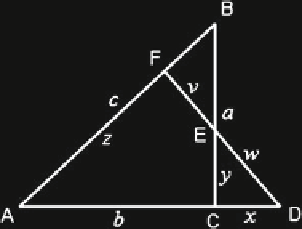Information Technology Reference
In-Depth Information
Fig. 18.5
Proof #56 in [
1
]
The above problem can be approached thoroughly and most efficiently with the
help of computers, as the combinatorial number of systems of equations that must
be examined exceeds the abilities of the average person. Actually, Bogomolny [
1
]
reports that B.F. Yanney and J.A. Calderhead found 4864 proofs from the above
set as early as 1896—at a time when computers were unavailable. There is no
claimmade, however, that this was an exhaustive search, nor that it was all correct.
Only computer searches can be reliable enough to draw trustworthy conclusions
in such cases, which brings us to this important observation: in a codelet-aided
system such as the proposed one, some of the codelets can be computer processes;
and in some cases, they must be computer processes. In general, whatever can be
automated, it better be automated and examined mechanically. Thus, the model
we envision should be flexible enough to allow for a mixture of human and
computerized agents.
In summary, this entire example regarding the Pythagorean Theorem suggests
that, for complex problems such as those in mathematics, the agents associated with
codelets at the highest level of the hierarchy will generally possess a higher level
of expertise or sophistication, as the tasks are likely to consist of things such as
reformulating a problem or task in a way that is more suitable for being treated by a
wider audience.
Also, a system like this would actually keep track of thewhole collective, dynamic,
non-linear process of making of a proof, and of its acceptance or rejection by indi-
viduals and the community.
18.7 Collective Intelligence as an Emerging Property
of Codelets in Web-Based Proof-Events
Collective creative thinking and collective memory are essential components of a
Web-based mathematical problem-solving approach. The Kumo assistant and the
Polymath project [
7
] are Web tools facilitating the collaboration of codelets, whereas
the Tatami and the Tricki projects [
9
,
20
] serve as repositories of the acquired
collective memory. The image of an individual mathematical mind, which is intel-


Search WWH ::

Custom Search